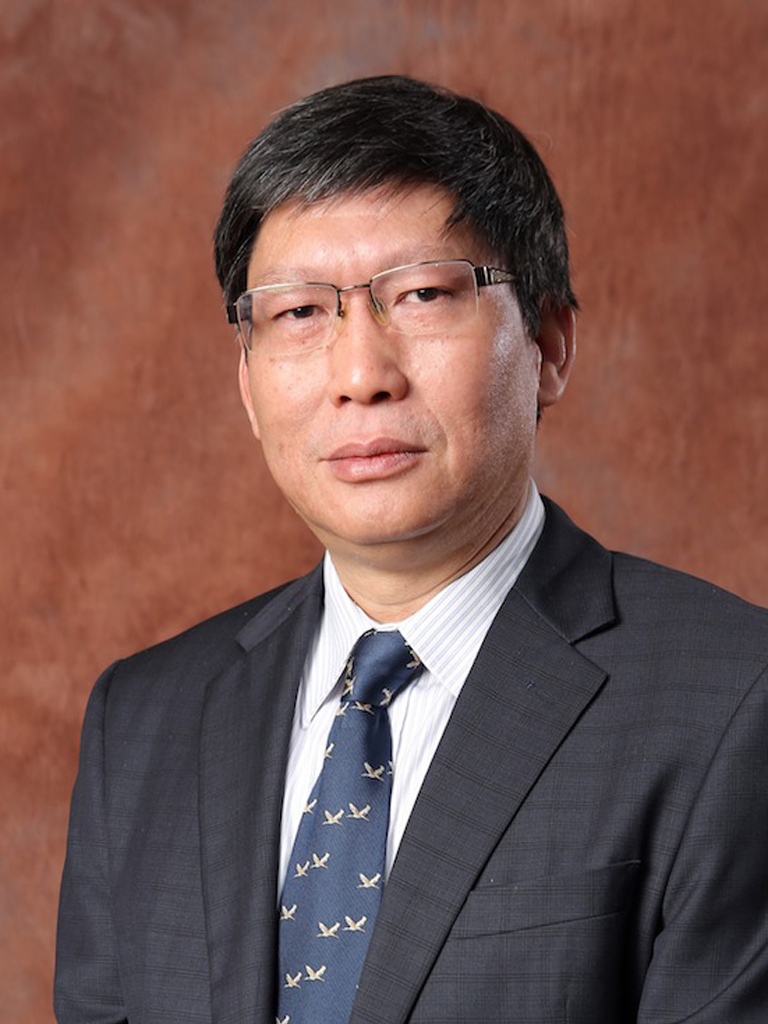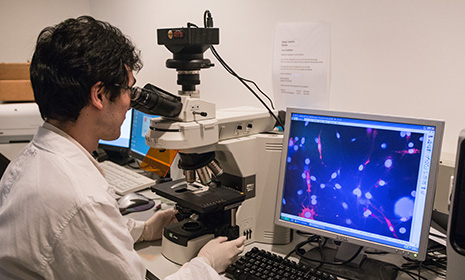Guan, Yi

Division of Public Health Laboratory Sciences
- MD(Jiangxi Med Coll), MMedSc(Beijing Union Med), PhD(HK)
Biography
Professor Yi Guan is the Director of the State Key Laboratory of Emerging Infectious Diseases, The University of Hong Kong. His research focuses on the ecology, evolution and pathogenesis of influenza and other emerging respiratory viruses. Over the past decade, his research team has made ground-breaking and distinguished contributions to research in virology and to the control of emerging infectious diseases in China and the world. His contribution to the field is reflected in his publication record of over 320 peer-reviewed articles with ~40,000 citations, and an h-index of 97.
Beginning in Year 2000, Professor Guan initiated and organized a systematic influenza surveillance network, in human, swine, poultry and migratory bird populations, in Southern China. Through this surveillance over 100,000 samples from poultry are collected each year, representing the single largest continuous and systematic sampling of these disease reservoirs. Along with providing the majority of World Health Organization recommended H5N1 and H9N2 pre-pandemic vaccine strains, the information from this surveillance program has provided the most comprehensive understanding of the ecology, evolution and dissemination of avian influenza viruses influenza viruses with pandemic potential worldwide.
In particular, his research on influenza has 1) identified all the major precursors and transmission pathways of the H5N1 influenza viruses that currently circulate in Southeast Asia, Europe and Africa; 2) initiated the systematic study of H9N2 viruses, which, along with H5 viruses, are now regarded as the most likely novel influenza subtypes to cause a pandemic; 3) defined the critical role of domestic ducks in harboring and spreading influenza viruses; 4) made major contributions in recognizing the emergence, evolutionary history and development of the 2009 H1N1 pandemic virus; and 5) revealed the genesis, infection source, evolutionary pathway and possible transmission route of the recently emerged H7N9 and H10N8 influenza virus.
He also initiated the SARS etiological investigation in Guangdong that resulted in the Department of Microbiology at HKU being the first research team to identify this emerging coronavirus and was the first to identify the virus in wild animal markets Guangdong showing this to be the interface for zoonotic transmission to humans. Hesubsequently organized and led the nationally coordinated investigation in China to determine the zoonotic source of SARS coronavirus, and advised the Chinese Government on control measures to successfully avert a second SARS outbreak in early 2004 in Guangdong.
His contributions on MERS have revealed the prevalence and evolution of the MERS coronavirus in its animal reservoir, which led to the human outbreaks in Korea and Saudi Arabia; and this work has identified a new coronavirus species co-circulating with the MERS coronavirus in camels. Recently during the COVID-19 outbreak, his team has found pangolin to be one of the hosts for SARS-like coronaviruses and international trading/smuggling could be a way for virus emergence from the zoonotic source.
Professor Yi Guan has consistently been ranked as a highly cited researcher (2014-2019) and has been ranked 11th in the world in the field of microbiology (Thomson 2014). His annual personal ranking has been 5th and 4th in the world, respectively, in the field of avian influenza and H1N1 influenza research, 2005 and 2009 (Thomson Institute of Scientific Information ISI Ranking). He has obtained substantial grant funding from the NIH of the USA, the Welcome Trust fund and the WHO as well as from local government sources and private foundations. “Time” magazine of the USA has twice featured him, first as one of 18 “Global Health Heroes” and later as an “Asian Hero”.
Selected Publications
- Lam TT-Y, Wang J, Shen Y, Zhou B, Duan L, Cheung C-L, Ma C, Lycett SJ, Leung CYH, Chen X, Li F, Hong W, Chai Y, Zhou L, Liang H, Ou Z, Liu Y, Farooqui, Kelvin DJ, Poon LLM, Smith DK, Pybus OG, Leung GM, Shu Y, Webster RG, Webby RJ, Peiris JSM, Rambaut A, Zhu H*, Guan Y*(2013)The genesis and source of the H7N9 influenza viruses causing human infections in China. Nature. 502(7470):241-4. [impact factor: 38.6, citation: 76]
- Zhu H, Wang D, Kelvin DJ, Li L, Zheng Z, Yoon SW, Wong SS, Farooqui A, Wang J, Banner D, Chen R, Zheng R, Zhou J, Zhang Y, Hong W, Dong W, Cai Q, Roehrl MH, Huang SS, Kelvin AA, Yao T, Zhou B, Chen X, Leung GM, Poon LL, Webster RG, Webby RJ, Peiris JS, Guan Y*, Shu Y* (2013) Infectivity, transmission, and pathology of human-isolated H7N9 influenza virus in ferrets and pigs. Science. 341(6142):183-186. [impact factor: 31.0; citation: 99]
- Vijaykrishna D, Smith GDJ, Pybus OG, Zhu H, Bhatt S, Poon LLM, Riley S, Bahl J, Ma SK, Cheung CL, Perera RAPM, Chen H, Shortridge KF, Webby RJ, Webster RG, Guan Y*, Peiris JSM*(2011) Long-term evolution and transmission dynamics of swine influenza A virus. Nature. 473(7348):519-522. [Impact factor: 38.6, citation: 70]
- Vijaykrishna D, Poon LLM, Zhu HC, Ma SK, Li OTW, Cheung CL, Smith GJD, Peiris JSM*, Guan Y*(2010) Reassortment of Pandemic H1N1/2009 Influenza A Virus in Swine. Science. 328: 1529-1529. [Impact factor: 31.0; citation: 170]
- Smith GJD, Bahl J, Vijaykrishna D, Zhang JX, Poon LLM, Chen H, Webster RG, Peiris JSM, Guan Y*(2009) Dating the emergence of pandemic influenza viruses. Proc Natl Acad Sci U S A. 106: 11709-11712.[Impact factor: 9.7; citation: 162]
- Smith GJ, Vijaykrishna D, Bahl J, Lycett SJ, Worobey M, Pybus OG, Ma SK, Cheung CL, Raghwani J, Bhatt S, Peiris JS, Guan Y*, Rambaut A*(2009) Origins and evolutionary genomics of the 2009 swine-origin H1N1 influenza A epidemic. Nature. 459: 1122-1125.[Impact factor: 38.6; citation: 875]
- Zhou BP, Zhong NS, Guan Y*(2007) Treatment with convalescent plasma for influenza A (H5N1) infection. N Engl J Med. 357: 1450-1451.[Impact factor: 51.7; citation: 105]
- Chen H, Smith GJD, Zhang SY, Qin K, Wang J, Li KS, Webster RG, Peiris JSM, Guan Y*(2005) Avian flu:H5N1 virus outbreak in migratory waterfowl. Nature. 436: 191-192.[Impact factor: 38.6; citation: 474]
- Guan Y, Peiris JS, Zheng B, Poon LL, Chan KH, Zeng FY, Chan CW, Chan MN, Chen JD, Chow KY, Hon CC, Hui KH, Li J, Li VY, Wang Y, Leung SW, Yuen KY, Leung FC (2004) Molecular epidemiology of the novel coronavirus that causes severe acute respiratory syndrome. Lancet. 363: 99-104.[Impact factor: 39.0; citation: 69]
- Li KS, Guan Y*, Wang J, Smith GJ, Xu KM, Duan L, Rahardjo AP, Puthavathana P, Buranathai C, Nguyen TD, Estoepangestie AT, Chaisingh A, Auewarakul P, Long HT, Hanh NT, Webby RJ, Poon LL, Chen H, Shortridge KF, Yuen KY, Webster RG, Peiris JS(2004) Genesis of a highly pathogenic and potentially pandemic H5N1 influenza virus in eastern Asia. Nature. 430: 209-213.[Impact factor: 38.6; citation: 928]








.png)
